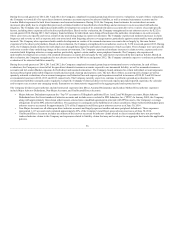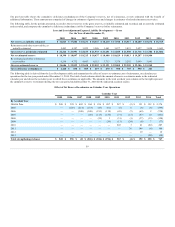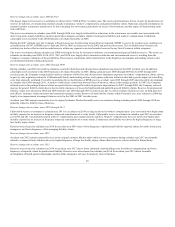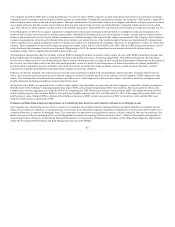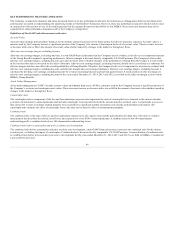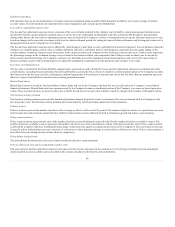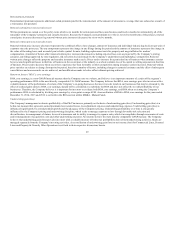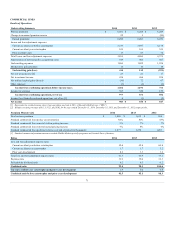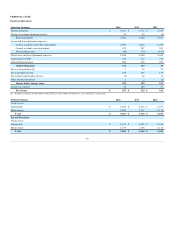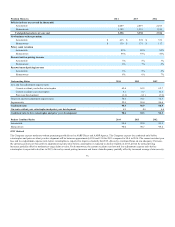The Hartford 2014 Annual Report Download - page 65
Download and view the complete annual report
Please find page 65 of the 2014 The Hartford annual report below. You can navigate through the pages in the report by either clicking on the pages listed below, or by using the keyword search tool below to find specific information within the annual report.
Valuation Allowance on Deferred Tax Assets
Deferred tax assets represent the tax benefit of future deductible temporary differences and operating loss and tax credit carryovers. Deferred tax assets are
measured using the enacted tax rates expected to be in effect when such benefits are realized if there is no change in tax law. Under U.S. GAAP, we test the
value of deferred tax assets for impairment on a quarterly basis at the entity level within each tax jurisdiction, consistent with our filed tax returns. Deferred
tax assets are reduced by a valuation allowance if, based on the weight of available evidence, it is more likely than not that some portion, or all, of the
deferred tax assets will not be realized. The determination of the valuation allowance for our deferred tax assets requires management to make certain
judgments and assumptions. In evaluating the ability to recover deferred tax assets, we have considered all available evidence as of December 31, 2014,
including past operating results, the existence of cumulative losses in the most recent years, forecasted earnings, future taxable income, and prudent and
feasible tax planning strategies. In the event we determine it is not more likely than not that we will not be able to realize all or part of our deferred tax assets
in the future, an increase to the valuation allowance would be charged to earnings in the period such determination is made. Likewise, if it is later determined
that it is more likely than not that those deferred tax assets would be realized, the previously provided valuation allowance would be reversed. Our judgments
and assumptions are subject to change given the inherent uncertainty in predicting future performance and specific industry and investment market
conditions.
The Company has recorded a deferred tax asset valuation allowance that is adequate to reduce the total deferred tax asset to an amount that will be more
likely than not realized. The deferred tax asset valuation allowance was $181, relating mostly to the U.S. capital loss carryover, as of December 31, 2014 and
$4, relating mostly to U.S. net operating losses, as of December 31, 2013. In assessing the need for a valuation allowance, management considered future
taxable temporary difference reversals, future taxable income exclusive of reversing temporary differences and carryovers, taxable income in open carry back
years, as well as other tax planning strategies. These tax planning strategies include holding a portion of debt securities with market value losses until
recovery, altering the level of tax exempt securities held, making investments that allow utilization of foreign tax credits, business considerations such as
asset-liability matching, and making investments which have specific tax characteristics. Management views such tax planning strategies as prudent and
feasible, and would implement them, if necessary, to realize the deferred tax asset.
Contingencies Relating to Corporate Litigation and Regulatory Matters
Management evaluates each contingent matter separately. A loss is recorded if probable and reasonably estimable. Management establishes reserves for these
contingencies at its “best estimate,” or, if no one number within the range of possible losses is more probable than any other, the Company records an
estimated reserve at the low end of the range of losses.
The Company has a quarterly monitoring process involving legal and accounting professionals. Legal personnel first identify outstanding corporate
litigation and regulatory matters posing a reasonable possibility of loss. These matters are then jointly reviewed by accounting and legal personnel to
evaluate the facts and changes since the last review in order to determine if a provision for loss should be recorded or adjusted, the amount that should be
recorded, and the appropriate disclosure. The outcomes of certain contingencies currently being evaluated by the Company, which relate to corporate
litigation and regulatory matters, are inherently difficult to predict, and the reserves that have been established for the estimated settlement amounts are
subject to significant changes. Management expects that the ultimate liability, if any, with respect to such lawsuits, after consideration of provisions made for
estimated losses, will not be material to the consolidated financial condition of the Company. In view of the uncertainties regarding the outcome of these
matters, as well as the uncertainties regarding tax-deductibility of payments, it is possible that the ultimate cost to the Company of these matters could
exceed the reserve by an amount that would have a material adverse effect on the Company’s results of operations or liquidity in a particular quarterly or
annual period.
65



